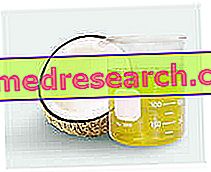Introduction
Gluten-free food and celiac disease treatment
Faced with a diagnosis of celiac disease, the only effective therapeutic intervention consists in the exclusive consumption of gluten-free foods . For most subjects, this dietary approach leads to the complete disappearance of clinical symptoms and remission of intestinal lesions.

Eliminate gluten-free foods: problems
Many of these foods are so rooted in the Mediterranean food culture, that their departure from the diet can cause many practical and psychological problems. As if that were not enough, cereals not permitted to celiacs are found in many food products, even in the form of additives.
Development of gluten-free foods
Fortunately, the increased sensitivity to the disease and its widespread diffusion (according to some sources would affect over half a million Italians) have led to the development of numerous diet products intended for this segment of the population.
Alongside naturally gluten-free foods, it is now possible to buy various substitutes for bread, pasta and baked goods, made with naturally gluten-free alternative flours.
What are gluten-free foods?
Definition of gluten-free food
According to the Italian celiac association (AIC), a food, to be called " gluten-free ", must not contain more than 20 mg of gluten per kg (20 ppm - parts per million).
Controlling the ingredients is not enough
Since it is essential for people with celiac disease to avoid foods containing even only traces of gluten, as regards certain categories of food products, the simple examination of the ingredients on the label does not guarantee the suitability of the product.
Despite the apparent absence of gluten, in fact, there may have been contamination during the production cycle, which is quite common in establishments that process wheat derivatives or other flours containing proteins that are toxic to celiac disease.
Spiga Barred
What does the "Spiga Barrata" trademark mean?
The symbol of the "spiga barata" - consisting of a fantasy drawing depicting an ear of corn cut from a segment - represents a certification of suitability for the celiac diet developed by the AIC (Italian Celiac Association).
The crossed ear is an easy and safe method to highlight the absence of gluten in the products offered by the market, since it is the result of the signing of a contract between the AIC and the manufacturing company, with consequent verification of the suitability of the products by the Italian celiac association.
All "Spiga Barred Mark" products are automatically inserted in the "AIC Food Handbook", an annual publication that collects, following evaluation, even those products which - although not specifically designed for a particular diet - are still suitable for consumption by the celiac subject.
Basic Rules
10 basic rules for the gluten-free diet
With a diagnosis of gluten intolerance or having a suspicion how much chin founded (see specific symptoms), these 10 tips will help you make gluten-free food choices easier.
- Carefully read the food labels upon purchase. Consult the list of ingredients and look for the "spiga barred". If a cereal containing gluten has been used as an ingredient (no matter how much), it will be mentioned in the list of ingredients; therefore pay attention to the mention of wheat, rye, barley, oats, spelled, kamut etc.
- Use gluten-free substitutes instead of gluten-containing foods. Traditional pasta, bread and crackers contain gluten, so without having to endure any waiver, you can choose the gluten-free alternatives found in most supermarkets and health food stores. Officially diagnosed celiacs can enjoy a medical prescription.
- Remember that most of the foods that make up the diet are naturally gluten-free. Fresh fruits and vegetables, meat, poultry, fish, cheese and eggs are naturally gluten-free. Use these foods as the basic ingredients of your meals, avoiding the already "processed" products, so that you can independently choose the type of cereal / flour / derivative to be used in the recipe.
- Use cereals and gluten-free flours. Following a gluten-free diet does not mean excluding all seeds, flours and cereals. Quinoa, teff, amaranth, corn and polenta, buckwheat, rice, millet and tapioca are just some of the naturally gluten-free grains that can be included in the diet. Just check the labels to make sure the products are not contaminated. Exchange traditional breadcrumbs with polenta crumbs, opt for buckwheat as an ingredient for pasta and try the brand new pseudocereals (amaranth, quinoa, etc.).
- Learn about alcohol free and containing gluten. They are gluten-free: cider, wine, sherry, liqueurs and port. Contains gluten: lager, stout and ales beers; wheat-based spirits (vodka, whiskey, etc.). Gluten-free beers are now widespread in various supermarkets and restaurants, but be sure to drink only those with the "spiga barred".
- Do not renounce conviviality. Following a gluten-free diet does not mean giving up eating out; it is enough to pay close attention.
- Pay attention to cross contamination. Little gluten is sufficient to cause symptoms for celiac disease; therefore, be sure to minimize the risk of cross contamination by washing the kitchen surfaces before use, using separate containers and instruments, limiting the spreading of crumbs and flour with gluten, and considering single-dose foods for celiacs.
- Avoid foods containing occult gluten. A lot of products, especially sauces, contain wheat flour as a thickener (therefore gluten); read the label and exclude any "suspicious" product.
- Experiment with new recipes. Find the right gluten-free substitute (most appreciated) for the usual ingredients containing gluten, so that you can replace them systematically and quickly.
- Remember that gluten-free meals can be just as healthy and enjoyable. See "Gluten Free Recipes" and gluten-free food tables below.
Cereals from which flours with celiac-toxic proteins are obtained
- Wheat
- Durum wheat
- Spelled Kamut (Egyptian wheat)
- Barley
- Rye
- spelled
- Triticale
Cereals and other products from which flours are obtained without proteins toxic for celiac disease
- Amaranth (pseudocereal)
- chestnuts
- Buckwheat (pseudocereal)
- Legumes (chickpeas, soya, etc.)
- Corn
- Mile
- Potato (tuber)
- Quinoa (pseudocereal)
- Rice
- Sesame
- Sorghum
- Tapioca
Does oat contain proteins that are toxic to celiac?
The toxicity of oats for the coel is still a subject of debate. In the past, in fact, it was excluded a priori from the celiac diet, while several studies depict it as relatively safe. In particular, if introduced pure, that is not contaminated by wheat, barley or rye proteins during processing, oats would not be harmful for the most part (99.4%) of celiacs.
On the other hand it has been observed that the presence or absence of adverse reactions changes according to the botanical variety of oats; it is therefore possible that the genetic expression of proteins toxic to celiac changes significantly depending on the product.
Bibliography:
- Can be taken in a gluten-free diet? A systematic review. Scand. J. Gastroenterol. Vol. 42, No. 2, pages 171-178
- Penagini F, Dilillo D, Meneghin F, Mameli C, Fabiano V, Zuccotti GV (Nov 18, 2013). "Gluten-free diet in children: an approach to nutritionally adequate and balanced diet". Nutrients (Review). 5 (11): 4553–65. doi: 10.3390 / nu5114553. PMC 3847748 Freely accessible. PMID 24253052.
- de Souza MC, Deschênes ME, Laurencelle S, Godet P, Roy CC, Djilali-Saiah I (2016). "Pure Oats as Part of the Canadian Gluten-Free Diet in Celiac Disease: The Need to Revisit the Issue.". Can J Gastroenterol Hepatol (Review). 2016: 1576360. doi: 10.1155 / 2016/1576360. PMC 4904650 Freely accessible. PMID 27446824.
- Comino I, Moreno Mde L, Sousa C (Nov 7, 2015). "Role of oats in celiac disease". World J Gastroenterol. 21 (41): 11825–31. doi: 10.3748 / wjg.v21.i41.11825. PMC 4631980 Freely accessible. PMID 26557006. It is necessary to consider that oats include many varieties, containing various amino acid sequences and showing different immunoreactivities associated with toxic prolamins. As a result, several studies have shown that the immunogenicity of oats varies depending on the cultivar consumed. Thus, it is essential to thoroughly study the variety of products used in food ingredients before including it in a gluten-free diet ”.
Gluten Free Recipes
We invite you to consult the list of gluten-free video recipes, offered by My-personaltrainer.it and our personal Cooker Alice.
Here is an example:
Gluten-free tart with apples and jam
X Problems with video playback? Reload from YouTube Go to Video Page Go to Video Recipes Section Watch the video on youtubeAIC list of gluten-free foods
The following is a list of foods that can be consumed freely by celiac, as they are naturally gluten-free or belong to food categories that are not at risk (during their production process there is no danger of cross-contamination).
| Cereals, flour and derivatives | Meat, Fish and Eggs | Fruit |
         |     |     |
| Vegetables and Legumes | Milk, Dairy, Cheese and substitutes | Drinks |
     |      |       |
| Confectionery | Fats, condiments and various | |
   |           | |
Most Used
| Gluten Free Foods | |
| Fruit, Vegetables and Legumes | |
| Artichoke | Lentils |
| Asparagus | Lettuce |
| Sweet peppers | lime |
| Avocado | mushrooms |
| broccoli | Olive |
| Brussels sprouts | onions |
| Cabbage | Pak choi |
| Cauliflower | Parsley |
| Celery | Pineapple |
| chard | Potatoes |
| Chickpeas | Pumpkin |
| coconut | Sauerkraut |
| Cucumber | Shallot |
| Aubergine | Soy |
| Garlic | spinach |
| Ginger | Zucchini |
| Fava beans | Tomato |
| Leek | Turnip |
| Lemon | Watercress |
| Meat, Fish and Vegan Substitutes | |
| NB . Make sure the food is not breaded or floured! | |
| Beef | Ground, even mixed |
| Cod | Pig |
| Chicken | Quorn Mince (vegetable meat substitute) |
| Cold cuts (as long as gluten-free) | Salmon |
| Duck | Mollusks and Crustaceans |
| Other fish | Trout |
| Lamb | Turkey |
| Cereals, grains, bread, biscuits, pasta, nuts and sweets | |
| Gluten-free bread | Mile |
| Gluten-free cereals | Peanuts |
| Gluten free oats | Oilseed flour (walnut, hazelnut, almond, etc.) |
| Amaranth | Porridge oats |
| Maranta arundinaceae starch | Potato |
| Various beans | Quinoa |
| Buckwheat | Rice |
| Manioc | Rice flakes |
| Chia | Various seeds, such as flax, pumpkin, sesame, poppy, sunflower etc. |
| Corn | Sorghum |
| Corn flakes | Soy |
| Linen | Tapioca |
| Gluten free oats | Teff |
| Granola (commonly called muesli) | Yucca |
| Condiments and sweets | |
| Coconut oil | Rice pudding |
| French mustard | Tomato sauce |
| Ground pepper | salt |
| Honey | Sesame oil |
| Horseradish | Sorbets |
| Marmalade | Syrups (made from gluten-free ingredients) |
| Jellies (without adding flour with gluten) | Tapioca pudding |
| Olive oil | |
| Drinks | |
| Gluten-free beer | Rum |
| Almond milk | Sparkling sodas / beverages, such as Coca-cola, Pepsi etc. |
| Fruit juices | Wine |
| Vodka (potato) | Rum |
| Milk and egg derivatives | |
| Butter | Milk |
| Cheeses (except blue cheese) | Sour cream |
| Cream | Yogurt |
| Eggs, all of them | |
| Ingredients, herbs and spices | |
| Gluten-free flour | Potato starch |
| Chemical yeast | Rice flour |
| Sodium bicarbonate | Soy flour |
| corn flour | Herbs such as basil, coriander, oregano, rosemary, thyme etc. |
| Cremor tartar | Spices, such as pimento, cinnamon, cloves, cumin, nutmeg, paprika etc. |



